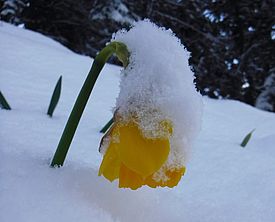02.05.2016 | News
A dry December amidst record high temperatures, followed by heavy snowfall, rain and storms – winter 2015/16 was highly varied and marked by slightly below-average fatal avalanche accidents.



White Christmas this winter was an unfulfilled wish, not only on the Swiss plateau but also in many mountain regions. In some parts of the Grisons mountains, such as Bivio, Davos and St. Antönien, the turn of the year displayed green slopes for the first time. Such conditions were brought about by record high December temperatures and a prolonged dry spell in early winter.
Above 1500 m a.s.l. in Ticino, snow depth was less than ever previously recorded at year’s end. According to MeteoSwiss, December temperatures in the mountain regions were 4-6 °C higher than average. Overall, it has been the second warmest winter*1 (November through April) since measurement-taking commenced in 1864.
The long-awaited snow didn’t arrive in the mountains until the beginning of January. Western Switzerland was by far the most favoured region as regards snow quantities. There was so much snowfall there in November that the lack of snow in December was less noticeable. In fact, mid-January snow depths were above average in some places over 1400 m a.s.l.. In stark contrast, the Swiss plateau was blanketed in white for only a few days. The end of winter was highly varied: while early in April springtime weather prevailed, in mid-April winter returned with snowfall and cold.
Lower avalanche danger overall
Heightened avalanche danger prevailed only in the period from January to the beginning of March. In the regions where snowfall was heaviest (e.g. Lower Valais, northern flank of the Alps) heavy snowfall, rain and storms brought about critical avalanche conditions. In areas with lesser snowfall (e.g. southern Upper Valais, northern Ticino, Grisons) avalanche danger levels were primarily caused by poor snowpack bonding.
In the second half of March the avalanche danger receded everywhere. Although a critical avalanche situation prevailed at the beginning of April with wet snow avalanches and again from the middle of April as a result of fresh fallen snow, the danger levels overall were below average in winter 2015/16. Danger level 1 (low) was forecast almost twice as often as on average over the last 10 years.
Slightly fewer avalanche victims
To date (deadline 30 April 2016) this winter, 18 people have lost their lives in avalanches. This is slightly less*2 than registered in other years by this date. Of the victims, 13 were backcountry ski tourers and 5 freeriding skiers. The long-term average number of avalanche victims for a whole year*2 is 23.
Avalanche bulletin
The avalanche bulletin continues to appear daily. It is available at www.slf.ch and via the SLF White Risk app. Subscribe to our RSS feed and text messaging service if you wish to be notified of the publication of an avalanche bulletin in early and late winter and/or during the summer. (To order the service, text START SLF SOMMER to 9234. To unsubscribe, text STOP SLF SOMMER to 9234. Texts cost CHF 0.20.)
An Alpine weather report in German is also available from MeteoSwiss www.meteoswiss.ch, by phone on 0900 162 138, (CHF 1.20/min.) or with the MeteoSwiss app.
*1 The warmest winter on the records so far is the winter 2006/07.
*2 The long-term average of 23 avalanche victims refers to one complete hydrological year which runs from 1 October until 30 September the following year. Until the end of April, the long-term average is 21 avalanche victims. The number of victims could still increase during the remainder of the hydrological year.
Contact ¶
Links and documents ¶
Copyright ¶
WSL and SLF provide the artwork for imaging of press articles relating to this media release for free. Transferring and saving the images in image databases and saving of images by third parties is not allowed.


